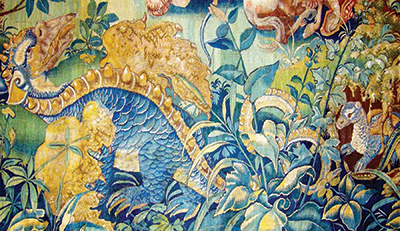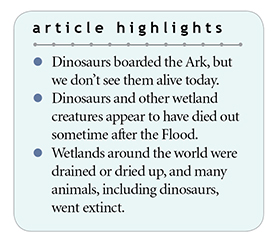.............................................................................................................................................
.
Dinosaurs were beasts, and their fossil nostrils
show they had the breath of life. So, if a breeding pair of every dinosaur kind
entered the Ark, why don’t we see dinosaurs alive today? Many other animal
kinds also died out after the Flood - they probably died out as each
region dried
BY BRIAN THOMAS, PH.D.
Genesis says that “every
beast after its kind… went into the ark to Noah, two by two, of all flesh in
which is the breath of life.”
Dinosaurs were beasts, and their fossil nostrils
show they had the breath of life.
So, if a breeding pair of every dinosaur kind
entered the Ark, why don’t we see dinosaurs alive today?
Mammal-like reptiles called synapsids left
Flood fossils and then later went extinct.
Other animals that vanished include the “bear
dogs,” rat-size morganucodonts, and Leptictidium, which walked like
a tiny, hairy tyrannosaur.
We can’t know specifics about their extinction
without going back in time, but three key clues sketch an answer.
We find one such clue in fossils.
Fossil evidence suggests that, like dinosaurs,
these other animals preferred watery homes.
The Flood buried dinosaur and synapsid fossils
along with water plants, fish, and wetland animals like turtles and crocodiles.
Swamp-loving creatures that got off the Ark
probably sought post-Flood wetlands.
The history of wetlands forms the second clue.
To this very day, “habitat
destruction is the leading cause of the global biodiversity [plant and animal]
loss in the world.”
Ancient lakes and marshes dried up for two main
reasons.
First, people drained swamps. Consider the Loire
Valley in central France. By the 1700s, locals had stabilized the Loire River’s
banks with planted trees.
 |
| The large reptile on the left of this tapestry from Chateau de Blois does not match any known creature, but the juvenile on the right resembles a maiasaur. |
But the medieval hunting lodges there show that
the land once held prized prey. The game disappeared with the loss of their
wetland homes.
A few castles show images of dinosaurs that
people may have hunted.
One famous tapestry at Chateau de Blois shows a
swamp scene with a baby maiasaur (duck-billed dinosaur) amidst Belgian plants.
Chateau de Chambord is covered with carvings of
a possible prosauropod like Plateosaurus.
Similarly, ancient English records identify
fens, or marshes, that once held immense reptiles. No wonder the monsters left
— locals had long since flushed and fenced the fens.
Wetlands in the Middle East dried up, too, but
for a different reason.
A recent dig at Azraq in Jordan identified
rhinoceros, lion, horse, elephant, duck, and human remains in Ice Age
sediments. It’s mostly desert today.
Another study surveyed crocodiles stranded in
isolated lakes in today’s Sahara Desert. They could not have crossed the desert
to get there, so they must have migrated during a wet past.
The study authors wrote, “Increased
aridity [drying] combined with human persecution led to local extinction.”
These stranded crocs are all that remain after
rain slowed as oceans cooled and the Ice Age ice melted.
A final clue comes from the Bible. In Job 40 God
seems to describe a dinosaur called behemoth living near the
Jordan River after the Flood.
The animal with a tail like a
tree was so immense that even if the river raged, “he is not
disturbed.”
Like other vast regions, the Jordan River Valley
dried up long ago — as did its lotus trees, reeds, willows, and behemoths.
What happened to dinosaurs and many other
wetland creatures after the Flood? They probably died out as each region dried.
* Dr.
Thomas is Research Associate at the Institute for Creation Research and earned
his Ph.D. in paleobiochemistry from the University of Liverpool.

No comments:
Post a Comment